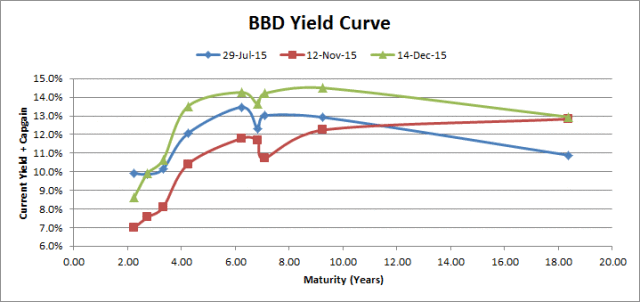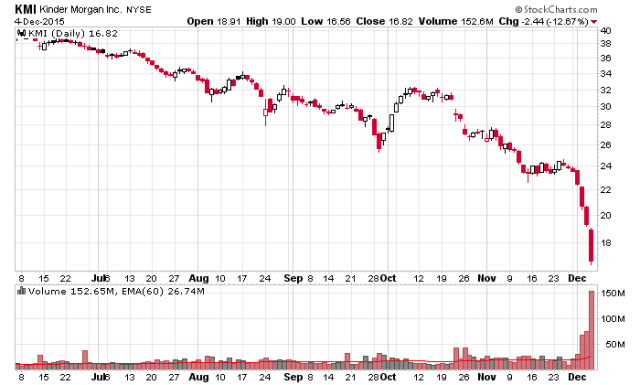Dundee Corporation (TSX: DC.A) has a preferred share series, Series 4, which trades as TSX: DC.PR.C. The salient features of the preferred share is a par value of $17.84, a 5% coupon, and a shareholder retraction feature which enables the shareholder to put the shares back to the company at par on or after June 30, 2016. The company has the right to redeem the preferred shares at $17.84 in cash or 95% of the market value of DC.A stock, or $2/share, whichever is higher.
I was going to wait for the management information circular to be released before definitively writing about this proposal, but my impatience got the better of me (in addition to me no longer being a preferred shareholder, which tells you what I think of the arrangement). James Hymas has written twice about this one (Link 1, Link 2) and his conclusion the was the same as mine when I read the arrangement: we both don’t like it.
Dundee announced they wish to change the terms of the preferred shares per the attached proposal as they do not wish to allocate what would functionally be a CAD$107.4 million cash outlay, puttable at any time by the preferred shareholders. The special meeting will be held on January 7, 2016 with the record date at December 3, 2015 (so shares purchased until November 30, 2015 are able to conduct business at the meeting with the typical 3 day settlement period).
Details of proposal
(ranked in my order from most important to least important)
1. Shareholder “put option” can only be exercised on June 30, 2019 (from the present date of June 30, 2016);
2. A consent payment for an early “yes” vote of $0.223 (one quarterly dividend coupon payment) and $0.1784 for the broker holding the shares!
3. Coupon goes from 5% to 6%;
4. Company will have redemption features above par (and at par at June 30, 2019) that realistically will not be triggered;
5. A “reverse split” at a ratio of 17.84/25 to adjust the par value of the preferred shares to $25/share making the math a little simpler;
The required vote is 2/3rds of the voting shareholders.
Analysis
Dundee Corporation is controlled by the Goodman family in a typical dual-class share structure. The corporation is a quasi-holding structure, with entities that are consolidated on the financial statements and some that are accounted for with the equity method. Thus, reading the income statement of the consolidated entity is not a terribly fruitful activity until one looks at the components. Most of the significant components are losing money. Considering that there are some heavy investments in oil and gas, and mining, this is to be expected. The best income-producing asset is the spun-off Dream Unlimited (TSX: DRM) which is a real estate development company. The take-home message is that the corporation as a whole is bleeding cash – about $25 million a quarter in 2015 to date.
Their balance sheet is not in terrible condition, but it is deteriorating – At Q3-2015 they reported $274 million in consolidated cash in addition to having a $250 million credit facility (with $93 million drawn) that expires in November 2016. However, most of the other assets are related to their heavy investments in the resource industry, which already received an impairment charge in Q3-2015, and likely to be impaired further.
So while it is very evident that Dundee will be able to pay their CAD$107 million preferred share liability when it is available to be redeemed on June 30, 2016 and beyond, the clause to extend the redemption date from June 30, 2016 to June 30, 2019 involves a pricing of significant credit risk over the incremental three year period, hence this deal being very unattractive for preferred shareholders – it is not entirely clear that the company will have any cash left to redeem the shares! The company does have the option to redeem the preferred shares in common shares of Dundee, but at this point the common shares might be worth under the CAD$2 threshold which is the minimum conversion rate.
Finally, the market does have valuation information on the other preferred share series trading – DC.PR.B and DC.PR.D – currently giving a 9% yield with no redemption possibilities – and this would suggest that the proposal of DC.PR.C, assuming a moderate “redemption” premium (i.e. with the shareholders receiving their money back in 3.6 years), would result in such shares trading at a minimum of 92 cents on the dollar, or roughly CAD$16.41 equivalent on today’s preferred share price (roughly a 4% price reduction on today’s CAD$17.00 trading price!). This assumes that there is equal “credit risk” with non-payment of dividends between now and the redemption date and no risk of receiving a lessened payment in 3.6 years – hence, 92 cents on the dollar would be a maximum valuation at present given market conditions.
Thus, the consent payment would need to be significantly higher than $0.223/share for preferred shareholders to be compensated for the extra three years of “holding risk” they are taking – my minimum estimate would be about $1.43/share for this to even be considered on par value, or $0.60/share when considering the existing market price of CAD$17. Taking the mid-point of this would be a $1/share consent payment. I would suggest that $0.60/share cash plus another $0.40/share in common stock be given for such a deal to be accepted. I’d love to see how the “fairness opinion” rationalizes this original deal being fair for shareholders – maybe fair for the company paying for the report!
Ethics
What is unusual about this proposal is that the intermediary (i.e. in most people’s cases, the broker that holds the shares) receives $0.1784/share that is tendered in favour of the deal. This clearly will create a conflict of interest between brokers and their clients. Ironically if that extra $0.1784 were applied to the beneficial shareholder, the proposal might have stood a higher chance of passing.
These tactics are clearly anti-shareholder and a huge red flag against management that would propose such a scheme.
Conclusion
My recommendation is that DC.PR.C preferred shareholders reject the proposal. It needs to be sweetened further.
I did sell all my shares between CAD$17.20 to CAD$17.44 on the open market last week and am happy to be rid of this headache.

